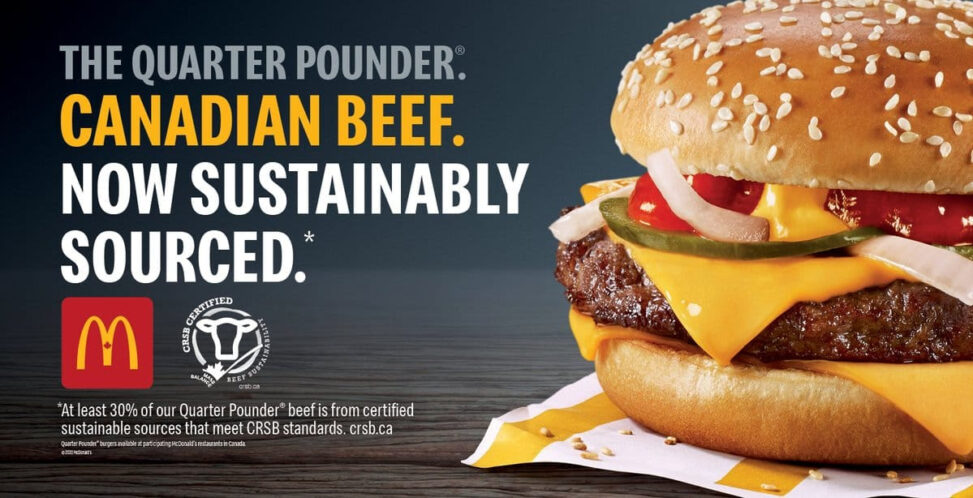Businesses can benefit by stating that they are taking matters on sustainability as it creates a sense of trust, credibility and market influence due to the social responsibility they are partaking in. Yet, that also entails a sense of accountability and loss of respect toward a business if they do not follow through with their commitments. A segment that has been impacted majorly by greenwashing is the food industry. Consumers aware of sustainability issues “are willingly altering their buying practices to purchase from companies that emphasize environmental responsibility.” (Northern 2024). A company that comes to mind when speaking of issues such as this would be McDonald’s, one of the biggest fast food businesses worldwide trying to earn more money doing so, which has stated its intent on becoming more sustainable but has shown little regard towards them.
The purpose of this ad is to motivate the viewer to buy a McDonald’s quarter pounder. McDonald’s ad wishes to accomplish this by stating that their hamburger patties are made with sustainably sourced Canadian beef. In this example, McDonald’s “producers and marketers aiming their activity at the young customer segment can treat it as a powerful influencer group within the still need-to-be ecologically educated societies.” (Kowalik, Leyge, and Sikora 2024). The target audience for this ad is likely to be young Canadians, as younger generations are more prone to environmentally friendly products and fast food being an option they usually would opt for. Additionally, the fact that this advertisement was in Canada implies that the Canadian population is the target audience, most likely because Canadians are well-educated on ecological matters. Therefore, it suggests that McDonald’s is trying to increase sales by using the term “sustainability” to attract its audience.
The example above shows an advertisement from McDonald’s published in 2020 trying to entice consumers to buy their product, the “quarter pounder”. The ad consists of a picture of the product to show a visual representation, a logo of the business to show their intellectual rights and the emblem of CBS certified to demonstrate proof for the consumer. Additionally, this advertisement utilizes three colours for their type: gray, yellow, and two white, with different values and sizes. These elements in this ad create a sense of hierarchy and a focal point for the viewer. In this advertisement, the first object that catches the attention is the ingredient of the product “Canadian Beef”, as it’s the only type with big yellow words making it stand out. Then, the attention is shifted toward the same size white type as the colour and size create more contrast with the background than the colour gray. Afterwards, the attention goes to the gray font letters that barely show any contrast. Lastly, the attention shifts to the small white type with a lower value below the logos, creating a sense of less importance. Thus, it makes the content written on it less likely to be read by consumers. (Hall Phillips, Yang, and Djamasbi, 2013).
Nevertheless, returning to the hierarchy that the ad follows, there is a crucial piece of evidence that most people would gloss over due to its size and the value of the type. Yet, that piece of information is a clarification that McDonald’s wanted people to gloss over as it might diminish what their goal was. In the small and faint white font it states, ” At least 30% of our Quarter Pounder beef is from certified sustainable sources that meet CRSB standards”, creating two inconsistencies according to a report from the Canadian Animal Justice Legislature. The first inconsistency is the logistics of having sustainability sourced beef and the implications of the small share they stated. The Canadian Animal Justice argues that cows generate massive quantities of methane, a greenhouse gas, making it impossible to sustainably source meat (Animal Justice, 2021). Additionally, the percent shown means that the “Quarter Pounders, on an individual basis, may only comprise 30% of so-called “sustainable beef” in any given circumstance. This would mean that 70% of the beef in certain burgers would not be verified as sustainably sourced by the CRSB. Broadly stating that the Quarter Pounder is sustainably sourced” (Animal Justice, 2021).
In conclusion, the intersection of sustainability and marketing presents both opportunities and challenges for businesses like McDonald’s. While promoting sustainable practices can enhance trust and credibility among consumers, the risk of greenwashing looms large, particularly in the food industry, where consumers are increasingly discerning about environmental claims. McDonald’s advertisement for the Quarter Pounder attempts to leverage the growing demand for sustainability among young Canadians, emphasizing that their beef is sustainably sourced. However, the fine print revealing that only a fraction of the meat meets certified sustainability standards raises questions about the sincerity of their claims. This discrepancy highlights the importance of transparency and accountability in corporate sustainability efforts. As consumers become more educated and vigilant, businesses must genuinely commit to sustainable practices or risk losing their credibility and consumer loyalty. Ultimately, the challenge lies in balancing profit motives with genuine responsibility toward environmental stewardship, as consumers continue to seek out brands that align with their values.
Bibliography:
Animal Justice. 2021. “Misleading McDonald’s Ads Removed after Animal Justice Files Legal Complaint.” Animal Justice. August 9, 2021. https://animaljustice.ca/media-releases/misleading-mcdonalds-ads-removed-after-animal-justice-files-legal-complaint.Hall Phillips,
Adrienne, Ruijiao Yang, and Soussan Djamasbi. 2013. “Thompson Rivers University Library – Library – Login to Licensed Databases.” Ezproxy.tru.ca. March 18, 2013. https://ieeexplore-ieee-org.ezproxy.tru.ca/document/6480027.
Kowalik, Izabela, Marine Leyge, and Tomasz Sikora. 2024. “Green Marketing and Greenwashing in Poland and France, a Comparison of Consumer Reactions.” International Journal of Contemporary Management 60 (1): 60–74. https://doi.org/10.2478/ijcm-2024-0002.
Northern, Greg. 2024. “Thompson Rivers University Library – Library – Login to Licensed Databases.” Ebsco.com. 2024. https://research.ebsco.com/c/amz5ui/viewer/pdf/4lzm6l2znb.


Jamaal Cooper
You effectively describe and critically analyze the greenwashing aspects of the advertisement. Explaining how the company uses sustainability claims to attract environmentally conscious consumers, specifically younger consumers. The analysis points out the discrepancy between McDonald’s broad sustainability claims and the reality revealed in the fine print, that only 30% of the beef is from certified sustainable sources.
The main points include McDonald’s attempt to appeal to younger, eco-friendly consumers, the company’s strategic emphasis on sustainability in advertising, and the issues of transparency when the claims do not fully align with actual practices. You argue that with McDonald’s use of the term “sustainably sourced” is misleading, leading to potential accusations of greenwashing.
The use of scholarly sources to support their essay, such as referencing the Canadian Animal Justice report, which questions the feasibility of sustainable beef. They also use research on consumer behaviour regarding sustainability, which strengthens their argument.
One area the student could explore further is the broader context of the CRSB standards and what they entail. Additionally, they could consider the impact of such greenwashing claims on consumer trust over time, beyond just the immediate effect of the ad. This would provide a deeper analysis of the long-term consequences for McDonald’s credibility.